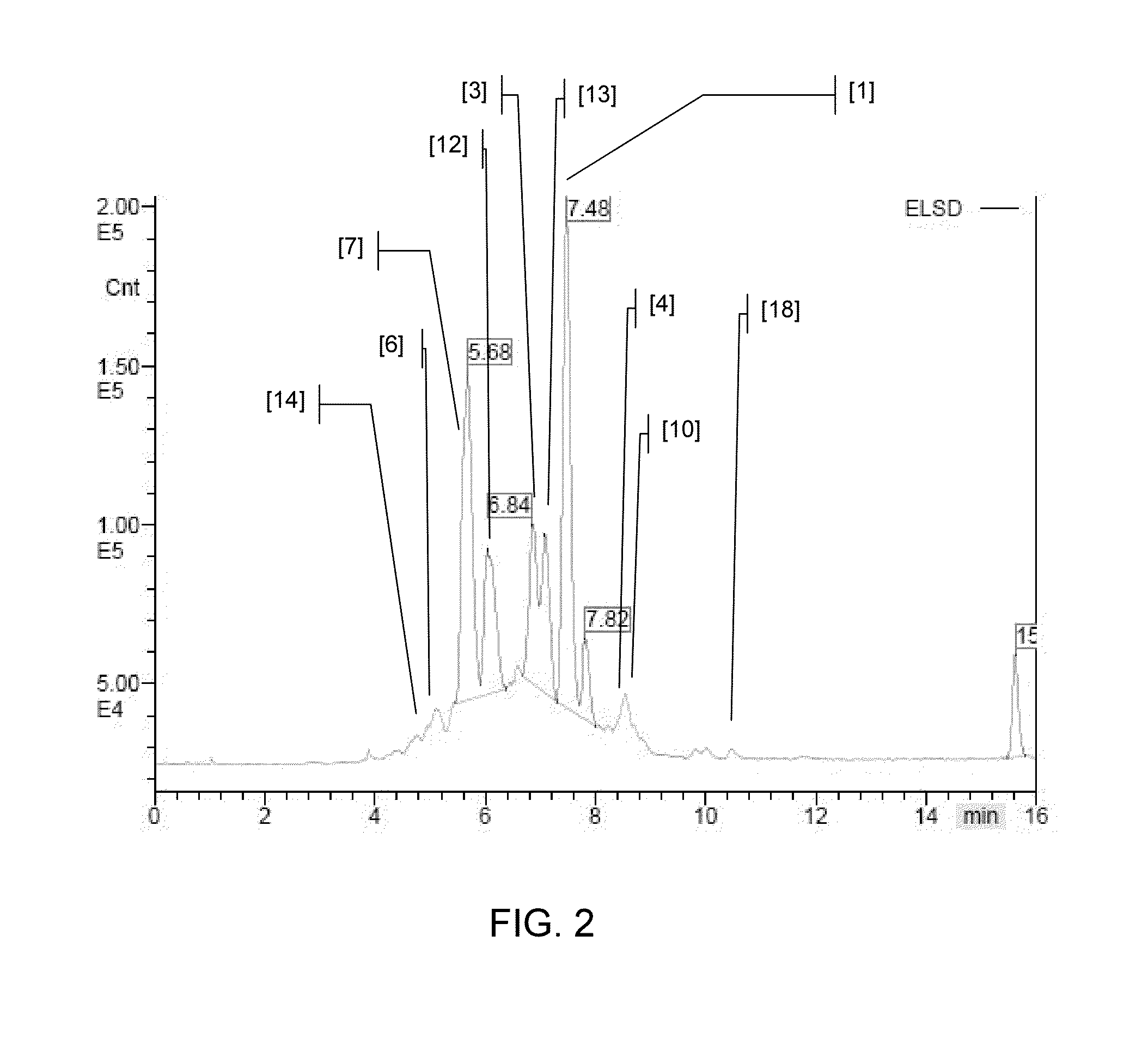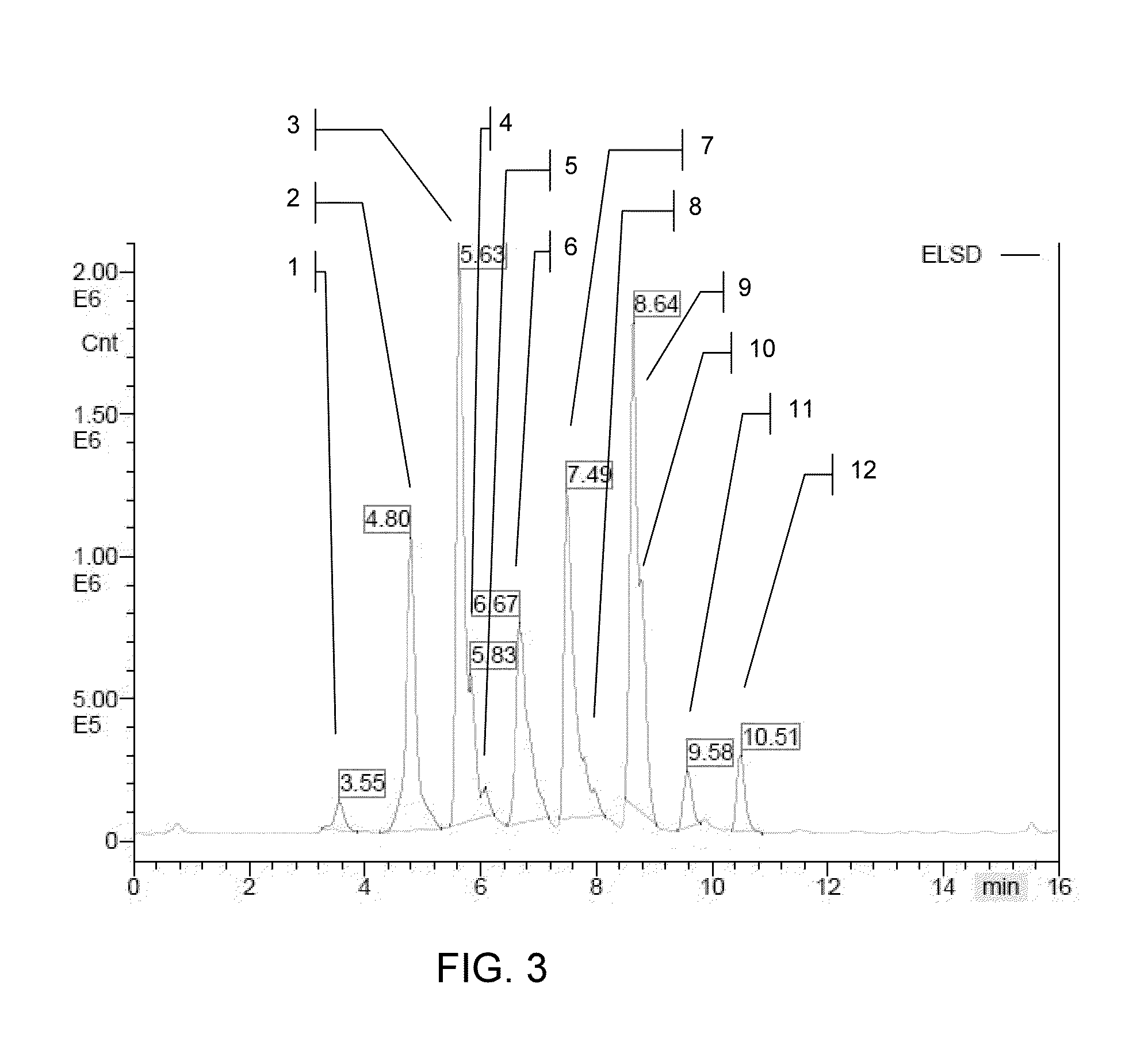Long chain glycolipids useful to avoid perishing or microbial contamination of materials
a technology of microbial contamination and long chain glycolipids, which is applied in the direction of antibacterial agents, biocides, hair cosmetics, etc., can solve the problems of reducing the shelf life or useful life of such products or goods, affecting the taste of products, and limited preservative effects in both duration and effect duration, so as to reduce the growth of microbial contaminants, reduce the ph value, and the effect of cost-effectiveness
- Summary
- Abstract
- Description
- Claims
- Application Information
AI Technical Summary
Benefits of technology
Problems solved by technology
Method used
Image
Examples
example 1
Cultivation
A) Media:
[0510]1) SDB (Sabouraud Dextrose Broth, Ref. 238230, Difco™ Lawrence, Kans., USA, containing 0.5% Peptic Digest of Animal Tissue, 0.5% Pancreatic Digest of Casein, 2.0% Dextrose, pH 5.6.[0511]2) YMG (Yeast-Malt-Glucose) medium: D-glucose 0.4% (Merck, Darmstadt, Germany, Ref. K25252846 831), malt extract 1% (Carl Roth, Karlsruhe, Germany, Ref. X976.2), yeast extract 0.4% (Merck, Darmstadt, Germany, Ref. 1.11926.1000), pH 6.3.[0512]3) PDB (Potato Dextrose Broth): 2.0% D-glucose, 0.4% mashed potatoes (Pfanni, Hamburg, Germany).[0513]4) Cornmeal medium (CM): 2.0% corn meal (Neuform, Zarrentin, Germany), 1.0% D-glucose.[0514]5) GM1 (Glucose-Yeast medium 1): 2.0% D-glucose, 0.5% yeast extract.[0515]6) GM2 (Glucose-Yeast medium 2): 2.0% D-glucose, 0.1% yeast extract.[0516]7) Malt medium 1: 2.0% malt extract, 0.5% yeast extract.[0517]8) Malt medium 2: 2.0% malt extract without yeast extract.[0518]9) Apple juice medium: 10% apple juice (common commercial product: clear ju...
example 2
Structural Characterisation
Compound No. [1]
[0542]The molecular structure was elucidated by thorough interpretation of high resolution mass spectrometric data and 1D and 2D NMR spectra. The structural characterisation follows the general methodology which is known to the person skilled in the art and described in more detail in the scientific literature (examples: Nishida et al., J. Antibiot. 1991, 44, 541; Nishida et al, Chem. Pharm. Bull. 1991, 39, 3044).
[0543]The numbering of the atoms is shown in FIG. 1.
[0544]Chemical Formula: C49H88O21
[0545]Exact Mass: 1012.5818 Da
[0546]Molecular Weight: 1013.2104 Da
[0547]HR-ESIMS: found m / z 1013.5874; calculated m / z 1013.5891 for [M+H]+
[0548]NMR spectra were obtained in CD3OD at 293 K on a Bruker DRX spectrometer operating at 500 MHz proton frequency. The residual solvent peak was used as internal reference (δH=3.30; δC=49.0). The assigned NMR data are summarized in Tables 5-14.
TABLE 5NMR data for Compound No. [1]aglycon moietycarbohydrate moi...
example 3
HPLC-UV-MS-ELSD Analysis
A General Methods
a) “Standard Method”
[0549]LC-MS / UVELSD analyses were performed using an Agilent HP1100 (Agilent, Waldbronn, Germany) liquid chromatograph coupled with a LCT mass spectrometer (Waters Corporation, Milford, Mass., USA) in the positive and negative electrospray ionization (ESI) mode and a Sedex 75 Evaporative Light Scattering Detector (Sedere, Alfortville Cedex, France). A Waters symmetry column (Waters Symmetry® (Trademark by Waters) C18, 3.5 μm, 2.1 mm×150 mm, Waters GmbH, Eschborn, Germany) was used as stationary phase with a flow rate of 0.4 ml / min at 40° C. Mobile phase A: 0.1% formic acid in water, mobile phase B: 0.1% formic acid in acetonitrile; gradient: 0-1 min. 98% A, from 1-21 min. to 100% B, from 21-27 min 100% B. The UVN is spectra were recorded between 200-500 nm, the LC-MS (Liquid Chromatography-Mass Spectrometry coupling) spectra were recorded in the range of molecular weights between 160 and 1.600 Da.
b) “Adapted Method”
[0550]LC...
PUM
| Property | Measurement | Unit |
|---|---|---|
| Fraction | aaaaa | aaaaa |
| Fraction | aaaaa | aaaaa |
| Composition | aaaaa | aaaaa |
Abstract
Description
Claims
Application Information
 Login to View More
Login to View More - R&D
- Intellectual Property
- Life Sciences
- Materials
- Tech Scout
- Unparalleled Data Quality
- Higher Quality Content
- 60% Fewer Hallucinations
Browse by: Latest US Patents, China's latest patents, Technical Efficacy Thesaurus, Application Domain, Technology Topic, Popular Technical Reports.
© 2025 PatSnap. All rights reserved.Legal|Privacy policy|Modern Slavery Act Transparency Statement|Sitemap|About US| Contact US: help@patsnap.com



